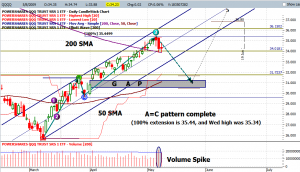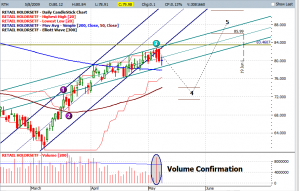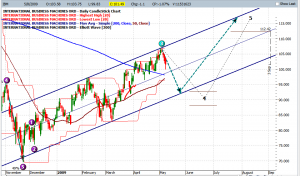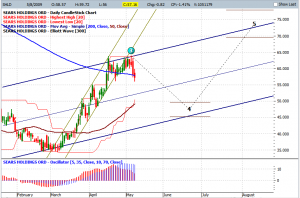Sector Rotation
Sector Rotation
Fujisan here.
I was going through Friday’s comments and many of you sound very emotional. I hope you are trading more than SPX.
I have briefly discussed this in my comments, but I thought that this may be a good topic to go over today, so that you have a better perspective of the the market place.
As many of you know, the basic premise of EW goes like this:
1. Impulsive Wave is initiated by Institutional Investors (“IIs”) – nowadays, this is synonymous to GS. When IIs are buying, they don’t buy all at once – they buy in increments. This is the strongest and longest wave and often counted as a “3rd” wave.
2. Once IIs are done buying, they start taking profits. This is a corrective wave and often counted as a “4th” wave.
3. Once IIs are done buying, Retail Investors (“RI”) step in and start buying. While RI are buying, IIs start selling into RI’s buying. This wave is counted as a “5th” wave, and as RIs do not have as much buying power as IIs, this wave is not as strong as a 3rd wave and typically ranges from 60%~100% of the previous impulsive wave.
Now, what happens in the market place is that, IIs won’t dump everything all at once. They would gradually shift their selloff from sector to sector, and this is called “sector rotation”.
As many of you noticed, high tech and retail sectors have been weak and not participated in the rally for the past couple of days because IIs started selling these sectors. If you look at 2003, there was 4 weeks time lag between NDX and SPX selloff.
Now, how do we know that II are done buying? Look at the volume coming out of the top at QQQQ and RTH. This is a “confirmation” and a sign of temporary top. In this regard, SPX has not yet shown a sign of weakness nor a confirmation of volume selloff, and it looks like SPX is trying to retest Jan 6 high at 946. 16 more points, guys!
Here is QQQQ chart. You can see a completion of A=C pattern here with a huge volume spike simultaneously presenting a very strong case that QQQQ is now rolling over to the downside. Please note that 100% ABC extension is $35.44, and Wed’s high was $35.34, which is short only by $0.10 cents.
Here is RTH. Same scenario with QQQQ, breaking out of the channel with volume spike.
I started looking at some high tech and retail stocks last week, and found more than a handful of stocks already rolled over, and I decided to go short these stocks. Remember, these are the stocks that would move higher when the rest of the market start coming down. I hope my today’s topic helps you to go after the stocks in weaker sectors instead of trying to time SPX top.
I have gone over RIMM, GS and AAPL on my Friday’s post, and here are some more.
This is IBM chart and price projection. I’m expecting IBM to come down to $95 area.
This is IBM’s 95/105 June call credit spread. This is to buy 105 June calls and sell 95 June calls to make it 95/105 credit spread. The reason that I am going with a credit spread instead of a debit spread is open interests. There are more open interests in call options than put options therefore better fill.
Here is SHLD chart and price projection. I’m expecting SHLD to come down to $50 area.
Here is SHLD June 60/50 Debit Put spread. This is to buy June 60 puts and sell June 50 puts to make it a debit spread.

Here is PX chart and price projection. I’m expecting PX to come down to retest the lower end of the current channel, which would be around $65.
Here is PX June/July 70/75 Diagonal. Diagonal is a combination of calendar spread and vertical spread. This is to buy July 75 call options and sell June 70 call options. I often use this strategy when there are not enough open interests.

These are just a few examples of my short list and I hope I could share more stocks with you, but many of them have already started to go much lower (!!) for the past 3 days regardless of the strong overall market sentiment. I hope this would give you an idea of what I am doing and hope you can do the same. One of the biggest advantages of trading multiple stocks is of course the diversification, but the other important element is a risk management.
When you are trading multiple stocks, you have to manage your positions systematically. I would ALWAYS put OCO orders in (for my stops and target, together with time stop (which is very important when you are dealing with depreciating assets)) so that I don’t need to watch them minute by minute. This also give you a discipline of following your own trading plan and don’t hang on to your losing trades.
If you don’t know how to trade spread, or your account won’t allow spread, just pick ATM options with 90 days to OPX and close it before 60 days in order to avoid theta burn.
This is the final chart that I like to share with you today. This is one of TK’s picks and guitarlover brought it to my attention last week. This is a “rare” W5 down stock, breaking out of 50 SMA and there is more room to the downside.
I have originally started the position with 30/25 June/July diagonal, but if you like to add on or start this position now, I would go with Jul 30/25 debit put spread.

We are finally getting a sunshine (which is a very unusual event in Seattle) and it looks like we have a sunny weekend.
Have a good weekend, everyone.
Fujisan
























